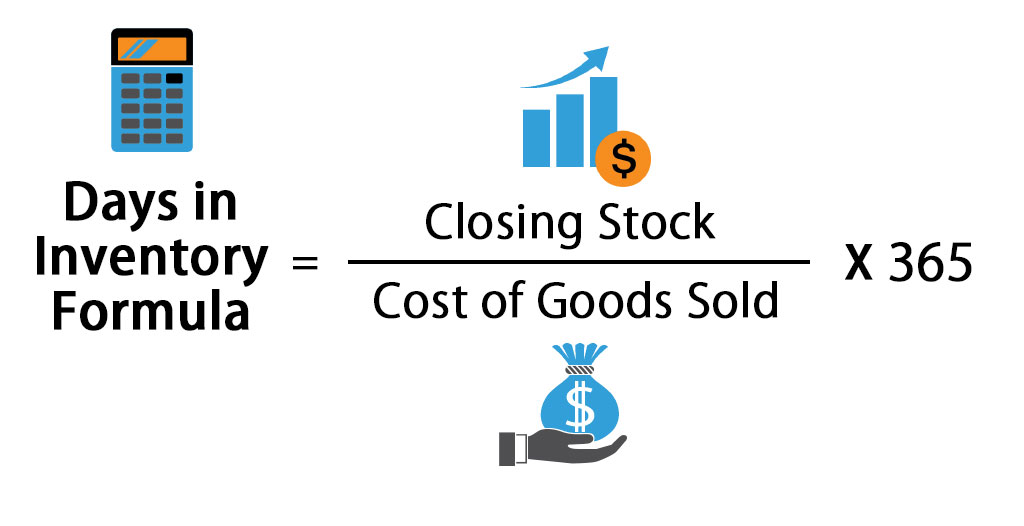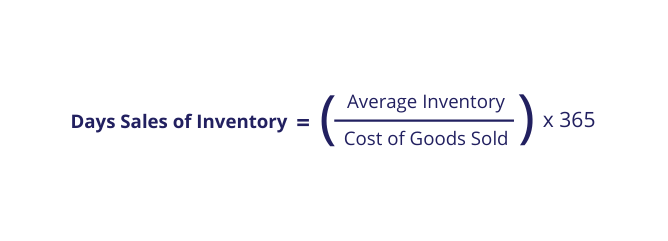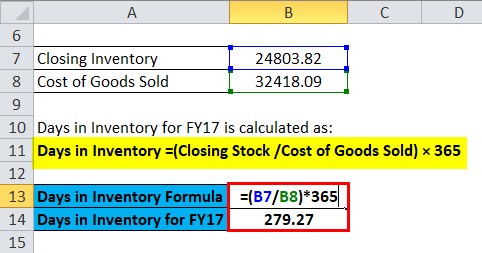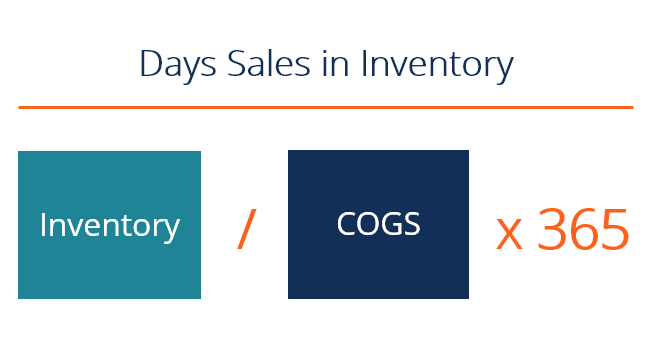days sales in inventory ratio interpretation
Inventory Turnover Days sales in inventory ratio or DSI is similar to the inventory turnover ratio but there are key differences in these measures. A high inventory turnover ratio implies either strong sales or ineffective buying the company buys too often in small quantities therefore the buying price is higherA high inventory turnover ratio can indicate better liquidity but it can also indicate a shortage or inadequate inventory levels which may lead to a loss in business.

Inventory Turnover Ratio Formula Meaning Example And Interpretation
Days inventory outstanding ratio explained as an indicator of inventory turns is an importantfinancial ratiofor any company with inventory.

. The number of days in a year 365 or 360 days divided by the inventory turnover ratio. Company A 123500 365 8979 days. Running A Profitable Business.
According to this formula the company has more than 3 months of inventory which is actually much higher than their target which was 2 months. DSI Average Inventory COGS x 365. I assume that inventory days is referring to the days sales in inventory.
This formula requires two variables. The average daily cost of merchandise sold is determined by dividing the cost of merchandise sold by 365. Using 360 as the number of days in the year the companys days sales in inventory.
Example of Days Sales in Inventory. Days Sales in Inventory Ratio vs. Days Sales Of Inventory Definition.
It is computed as follows. Can also be calculated as. In general a decrease in DIO is an improvement to working capital and an increase is deterioration.
Heres a sample 2019 Days Sales in Inventory calculation for each noting that Cost of Goods Sold for 2019 was 6208 million. To calculate average inventory value simply add your beginning inventory valuation to your ending inventory valuation and divide the sum by 2. It is sometimes called the stock days ratio.
DSI 365 IT. Sales for the last year 125000 at 45 margin. All inventories are a summation of finished goods work in progress and progress payments.
Days Sales in Raw Materials 365 121 6208 7 days. High or rising inventory to sales ratio indicates that the company is incurring more storage and holding cost. For instance when the inventory turnover is low the days sales in inventory will be high.
The financial ratio days sales in inventory tells you the number of days it took a company to turn its inventory also known as inventory turnover. It includes material cost. If so then inventory days is also related to the inventory turnover ratio.
When the inventory turnover is high the days sales in inventory will be low. It can also be calculated by dividing the inventory turnover ratio by 365. Definition of Inventory Days.
To illustrate the days sales in inventory lets assume that in the previous year a company had an inventory turnover ratio of 9. Days Sales in Inventory DSI sometimes known as inventory days or days in inventory is a measurement of the average number of days or time required for a business to convert its inventory Inventory Inventory is a current asset account found on the balance sheet consisting of all raw materials work-in-progress and finished goods that a into sales. It is calculated by dividing inventory by average daily cost of goods sold.
Days Inventory Outstanding Average inventory Cost of sales x Number of days in period. Average annual inventory Cost of goods 365 days. The days sales in inventory ratio also known as days stock outstanding or days in stock measures the amount of times it is going to take a business to market all its stock.
What this means is that Company A takes around 89 days to sell all of its Inventory during a year. It is done by showing the number of data points that fall within a specified range of values which is knowns as bins. By employing the alternative formula we can confirm that the result of this calculation is correct.
The days sales of inventory DSI is a financial ratio that indicates the average time in days that a company takes to turn its inventory including goods that are a. Lets walk through an example. The calculation formula for the number of days sales in inventory.
Amazon Days Sales in Inventory is another effective way to measure how well you manage your FBA business. It is an analytical tool used to gauge the operational efficiency of a business. Another technique thats sometimes used for calculating inventory turnover is sales divided by.
Days Sales in Work in Process 365 414 6208 24 days. Suppose there is a company whose days inventory outstanding DIO is 437 days and days sales outstanding DSO as 944 days. Day of Sales in Inventory 183 2506666 1446000 105 days.
Average inventory Beginning inventory Ending inventory 2. As a result Company B has a smaller CDR or DPO ratio. As you might know to find the average inventory for the period you will sum up the beginning and ending balances which can be located in the Balance sheet and divide the amount by two.
What is the formula for Inventory Days Ratio. The number of days sales in inventory measures the length of time it takes to acquire sell and replace the inventory. The inventory days ratio or days in inventory ratio shows the average number of days sales a business is holding in its inventory.
Days Sales in Inventory can be calculated by dividing the average inventory by the cost of goods sold and then multiplying the result by 365 to get DSI for a year. To put it differently the times sales in inventory ratio reveals the number of days per firms recent asset of stock will continue. Formula and Interpretation.
The inventory days is calculated using the following formula. Days Sales in Finished Goods 365 339 6208 20 days. A fictitious company reports that.
DSO Accounts ReceivablesNet Credit SalesRevenue 365. Days sales in inventory can also be called days inventory outstanding or the average age of an inventory. Company B 123800 365 5611 days.
This indicates that Company As funds were blocked in inventories for almost 89 days. Dsi Formula To Measure Inventory Performance. However for companies with goods still in production you have to include them to get accurate ending.
The calculation of the days sales in inventory is. Days sales in inventory DSI refers to a financial ratio showing the number of days a company takes to turn over all its inventory. Net sales and average inventory.
Cost of Goods Sold or COGS 50000. A good rule of thumb is to keep your DSI rate within industry benchmarks. Cost of Sales is also known as Costs of Goods Sold Cost of Goods Sold COGS Cost of Goods Sold COGS measures the direct cost incurred in the production of any goods or services.
Importance Of Days Sales Inventory To Businesses And Investors. Inventory to sales ratio measures the rate at which the company is liquidating its stocks. Inventory turnover Cost of Goods Sold Average inventory value.

Formula To Calculate Inventory Turns Inventory Turnover Rate

Days Sales In Inventory Definition Formula Calculated Example Analysis

Days In Inventory Formula Calculator Excel Template

Days Sales Outstanding Dso Formula And Excel Calculator

Inventory Turnover Ratio Formula And Tips For Improvement

Days Sales Outstanding Formula Meaning Example And Interpretation

Inventory Days Formula Meaning Example And Interpretation

Days Inventory Outstanding Dio Formula And Excel Calculator

Days In Inventory Formula Calculator Excel Template

Inventory Days Formula How To Calculate Days Inventory Outstanding

Inventory Turnover Ratio Days Sales In Inventory The Two Restaurant Inventory Metrics That Will Help You Squash Food Cost Maximize Profits Apicbase

Inventory Days Formula Meaning Example And Interpretation

Inventory Days Double Entry Bookkeeping

Days Sales In Inventory Dsi Overview How To Calculate Importance

Ineventory Turnover And Days Sales In Inventory Ratios Youtube

Examine The Efficiency Of Inventory Management Using Financial Ratios Principles Of Accounting Volume 1 Financial Accounting

Examine The Efficiency Of Inventory Management Using Financial Ratios Principles Of Accounting Volume 1 Financial Accounting

